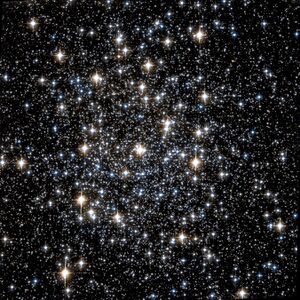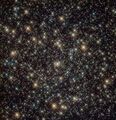Astronomy:NGC 3201
| NGC 3201 | |
|---|---|
 NGC 3201 by Hubble Space Telescope; 3.5′ view | |
| Observation data (J2000 epoch) | |
| Class | X[1] |
| Constellation | Vela |
| Right ascension | 10h 17m 36.82s[2] |
| Declination | –46° 24′ 44.9″[2] |
| Distance | 16.3 kly (5.0 kpc)[3] |
| Apparent magnitude (V) | +8.24[4] |
| Apparent dimensions (V) | 18.2′ |
| Physical characteristics | |
| Mass | 1.57×105[5] M☉ |
| Radius | 40 ly[6] |
| VHB | 14.77 |
| Metallicity | [math]\displaystyle{ \begin{smallmatrix}\left[\ce{Fe}/\ce{H}\right]\end{smallmatrix} }[/math] = –1.24[7] dex |
| Estimated age | 12.2±0.5 Gyr[8] |
| Other designations | GCl 15,[4] GC 2068, h 3238, Dun 445, Bennett 44, Caldwell 79,[9] Melotte 99 |
NGC 3201 (also known as Caldwell 79) is a low galactic latitude globular cluster in the southern constellation of Vela. It has a very low central concentration of stars.[10] This cluster was discovered by James Dunlop on May 28, 1826 and listed in his 1827 catalogue. He described it as "a pretty large pretty bright round nebula, 4′ or 5′ diameter, very gradually condensed towards the centre, easily resolved into stars; the figure is rather irregular, and the stars are considerably scattered on the south".[11]
The radial velocity of this cluster is unusually high at 490 km/s, larger than any other cluster known. This corresponds to a peculiar velocity of 240 km/s. While high, this is lower than the escape velocity of the Milky Way galaxy.[11] It is located at a distance of 16,300 light years from the Sun and has an estimated 157,000 times the mass of the Sun.[5] This cluster is about 10.24 billion years old.[7]
The stellar population of this cluster is inhomogeneous, varying with distance from the core. The effective temperature of the stars shows an increase with greater distance, with the redder and cooler stars tending to be located closer to the core. As of 2010, this is one of only two clusters (including Messier 4) that shows a definite inhomogeneous population.[12]
Black holes
Because NGC 3201 is a less dense globular cluster, far from undergoing core collapse, it is believed to harbor a substantial black hole population in its core. Indeed, a few black holes have been detected in this cluster,[13][14] orbiting nearby stars. In a study from 2022,[5] the movement of stars near the cluster's core derived from data gathered by the Hubble Space Telescope and the European Space Agency's Gaia spacecraft indicated that NGC 3201 has a sub-cluster of stellar mass black holes, with a total mass of roughly a thousand solar masses. The same study showed, with dynamical simulations, that this sub-cluster could contain nearly a hundred black holes.[15]
Gallery
Astronomers discovered a black hole at the heart of NGC 3201.[16]
Artist's impression of the black hole binary system in NGC 3201.[17]
See also
References
- ↑ Shapley, Harlow; Sawyer, Helen B. (August 1927), "A Classification of Globular Clusters", Harvard College Observatory Bulletin 849 (849): 11–14, Bibcode: 1927BHarO.849...11S.
- ↑ 2.0 2.1 Goldsbury, Ryan et al. (December 2010), "The ACS Survey of Galactic Globular Clusters. X. New Determinations of Centers for 65 Clusters", The Astronomical Journal 140 (6): 1830–1837, doi:10.1088/0004-6256/140/6/1830, Bibcode: 2010AJ....140.1830G.
- ↑ Paust, Nathaniel E. Q. et al. (February 2010), "The ACS Survey of Galactic Globular Clusters. VIII. Effects of Environment on Globular Cluster Global Mass Functions", The Astronomical Journal 139 (2): 476–491, doi:10.1088/0004-6256/139/2/476, Bibcode: 2010AJ....139..476P.
- ↑ 4.0 4.1 "NGC 3201". SIMBAD. Centre de données astronomiques de Strasbourg. http://simbad.u-strasbg.fr/simbad/sim-basic?Ident=NGC+3201.
- ↑ 5.0 5.1 5.2 Vitral, Eduardo; Kremer, Kyle; Libralato, Mattia; Mamon, Gary A.; Bellini, Andrea (2022), "Stellar graveyards: clustering of compact objects in globular clusters NGC 3201 and NGC 6397", Monthly Notices of the Royal Astronomical Society 514: 806, doi:10.1093/mnras/stac1337, Bibcode: 2022MNRAS.514..806V
- ↑ distance × sin( diameter_angle / 2 ) = 40 ly. radius
- ↑ 7.0 7.1 Forbes, Duncan A.; Bridges, Terry (May 2010), "Accreted versus in situ Milky Way globular clusters", Monthly Notices of the Royal Astronomical Society 404 (3): 1203–1214, doi:10.1111/j.1365-2966.2010.16373.x, Bibcode: 2010MNRAS.404.1203F.
- ↑ Monty, Stephanie; Puzia, Thomas H.; Miller, Bryan W.; Carrasco, Eleazar R.; Simunovic, Mirko; Schirmer, Mischa; Stetson, Peter B.; Cassisi, Santi et al. (2018), "The GeMS/GSAOI Galactic Globular Cluster Survey (G4CS). I. A Pilot Study of the Stellar Populations in NGC 2298 and NGC 3201", The Astrophysical Journal 865 (2): 160, doi:10.3847/1538-4357/aadb43, Bibcode: 2018ApJ...865..160M
- ↑ "NGC 3201", Deep Sky Observer's Companion, http://www.docdb.net/show_object.php?id=ngc_3201, retrieved 2012-04-28.
- ↑ Webb, N. A.; Wheatley, P. J.; Barret, D. (2005), "XMM-Newton X-ray and optical observations of the globular clusters M 55 and NGC 3201", Astronomy & Astrophysics 445: 155–165, doi:10.1051/0004-6361:20053010, Bibcode: 2005yCat..34450155W.
- ↑ 11.0 11.1 O'Meara, Stephen James (2002), The Caldwell Objects, Deep-Sky Companions, Cambridge University Press, pp. 314–315, ISBN 978-0521827966, https://books.google.com/books?id=3Hg6YHgx9nAC&pg=PA314.
- ↑ Kravtsov, V. et al. (March 2010), "Evidence of the inhomogeneity of the stellar population in the differentially reddened globular cluster NGC 3201", Astronomy and Astrophysics 512: L6, doi:10.1051/0004-6361/200913749, Bibcode: 2010A&A...512L...6K.
- ↑ Giesers, Benjamin; Dreizler, Stefan; Husser, Tim-Oliver; Kamann, Sebastian; Anglada Escude, Guillem (2018), "A detached stellar-mass black hole candidate in the globular cluster NGC 3201", Monthly Notices of the Royal Astronomical Society 475: L15, doi:10.1093/mnrasl/slx203, Bibcode: 2018MNRAS.475L..15G
- ↑ Giesers, Benjamin; Kamann, Sebastian; Dreizler, Stefan; Husser, Tim-Oliver; Askar, Abbas (2019), "A stellar census in globular clusters with MUSE: Binaries in NGC 3201", Astronomy & Astrophysics 632: A3, doi:10.1051/0004-6361/201936203, Bibcode: 2019A&A...632A...3G
- ↑ "Chasser des trous noirs dans un cimetière d'étoiles". 10 June 2022. https://www.insu.cnrs.fr/fr/cnrsinfo/chasser-des-trous-noirs-dans-un-cimetiere-detoiles.
- ↑ "Standout stars". http://www.spacetelescope.org/images/potw1804a/.
- ↑ "Odd Behaviour of Star Reveals Lonely Black Hole Hiding in Giant Star Cluster". https://www.eso.org/public/news/eso1802/.
External links
- Globular Cluster NGC 3201 at SEDS pages
- NGC 3201 on WikiSky: DSS2, SDSS, GALEX, IRAS, Hydrogen α, X-Ray, Astrophoto, Sky Map, Articles and images
- NGC 3201 at DOCdb (Deep Sky Observer's Companion)
Coordinates: ![]() 10h 17m 36.76s, −46° 24′ 40.4″
10h 17m 36.76s, −46° 24′ 40.4″
 |




